2005 BUICK LACROSSE steering wheel
[x] Cancel search: steering wheelPage 273 of 410
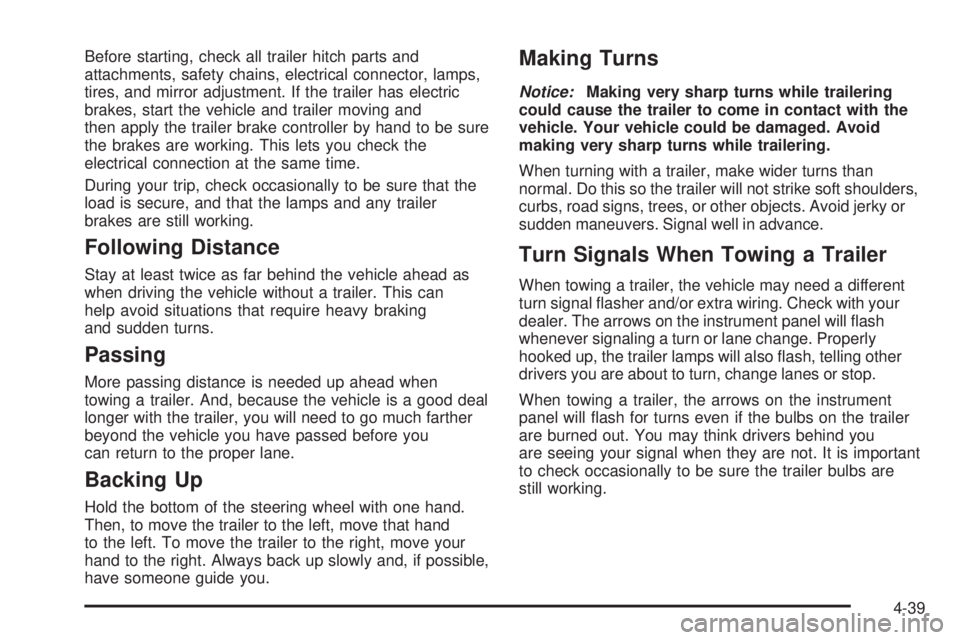
Before starting, check all trailer hitch parts and
attachments, safety chains, electrical connector, lamps,
tires, and mirror adjustment. If the trailer has electric
brakes, start the vehicle and trailer moving and
then apply the trailer brake controller by hand to be sure
the brakes are working. This lets you check the
electrical connection at the same time.
During your trip, check occasionally to be sure that the
load is secure, and that the lamps and any trailer
brakes are still working.
Following Distance
Stay at least twice as far behind the vehicle ahead as
when driving the vehicle without a trailer. This can
help avoid situations that require heavy braking
and sudden turns.
Passing
More passing distance is needed up ahead when
towing a trailer. And, because the vehicle is a good deal
longer with the trailer, you will need to go much farther
beyond the vehicle you have passed before you
can return to the proper lane.
Backing Up
Hold the bottom of the steering wheel with one hand.
Then, to move the trailer to the left, move that hand
to the left. To move the trailer to the right, move your
hand to the right. Always back up slowly and, if possible,
have someone guide you.
Making Turns
Notice:Making very sharp turns while trailering
could cause the trailer to come in contact with the
vehicle. Your vehicle could be damaged. Avoid
making very sharp turns while trailering.
When turning with a trailer, make wider turns than
normal. Do this so the trailer will not strike soft shoulders,
curbs, road signs, trees, or other objects. Avoid jerky or
sudden maneuvers. Signal well in advance.
Turn Signals When Towing a Trailer
When towing a trailer, the vehicle may need a different
turn signal �asher and/or extra wiring. Check with your
dealer. The arrows on the instrument panel will �ash
whenever signaling a turn or lane change. Properly
hooked up, the trailer lamps will also �ash, telling other
drivers you are about to turn, change lanes or stop.
When towing a trailer, the arrows on the instrument
panel will �ash for turns even if the bulbs on the trailer
are burned out. You may think drivers behind you
are seeing your signal when they are not. It is important
to check occasionally to be sure the trailer bulbs are
still working.
4-39
Page 277 of 410

Service............................................................5-3
Doing Your Own Service Work.........................5-4
Adding Equipment to the Outside of Your
Vehicle......................................................5-5
Fuel................................................................5-5
Gasoline Octane............................................5-5
Gasoline Speci�cations....................................5-6
California Fuel...............................................5-6
Additives.......................................................5-6
Fuels in Foreign Countries...............................5-7
Filling the Tank..............................................5-8
Filling a Portable Fuel Container.....................5-10
Checking Things Under the Hood....................5-10
Hood Release..............................................5-11
Engine Compartment Overview.......................5-12
Engine Oil...................................................5-15
Engine Oil Life System..................................5-18
Engine Air Cleaner/Filter................................5-19
Automatic Transmission Fluid.........................5-21
Engine Coolant.............................................5-21
Radiator Pressure Cap..................................5-24
Engine Overheating.......................................5-24
Overheated Engine Protection
Operating Mode........................................5-26
Cooling System............................................5-26Power Steering Fluid.....................................5-33
Windshield Washer Fluid................................5-34
Brakes........................................................5-35
Battery........................................................5-38
Jump Starting...............................................5-39
Headlamp Aiming...........................................5-43
Bulb Replacement..........................................5-45
Halogen Bulbs..............................................5-45
Headlamps and Sidemarker Lamps.................5-46
Front Turn Signal and Parking Lamps..............5-47
Fog Lamps..................................................5-48
Taillamps, Turn Signal, Sidemarker,
Stoplamps and Back-up Lamps...................5-48
Windshield Wiper Blade Replacement..............5-51
Tires..............................................................5-52
Tire Sidewall Labelling...................................5-53
Tire Terminology and De�nitions.....................5-55
In�ation - Tire Pressure.................................5-58
Tire Inspection and Rotation...........................5-60
When It Is Time for New Tires.......................5-61
Buying New Tires.........................................5-62
Uniform Tire Quality Grading..........................5-63
Wheel Alignment and Tire Balance..................5-64
Wheel Replacement......................................5-65
Section 5 Service and Appearance Care
5-1
Page 331 of 410
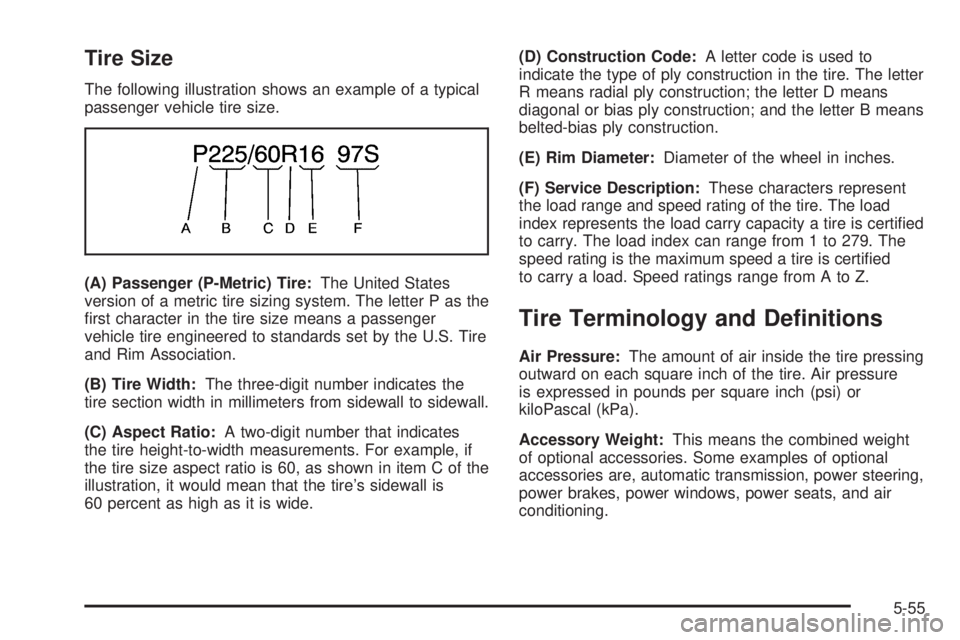
Tire Size
The following illustration shows an example of a typical
passenger vehicle tire size.
(A) Passenger (P-Metric) Tire:The United States
version of a metric tire sizing system. The letter P as the
�rst character in the tire size means a passenger
vehicle tire engineered to standards set by the U.S. Tire
and Rim Association.
(B) Tire Width:The three-digit number indicates the
tire section width in millimeters from sidewall to sidewall.
(C) Aspect Ratio:A two-digit number that indicates
the tire height-to-width measurements. For example, if
the tire size aspect ratio is 60, as shown in item C of the
illustration, it would mean that the tire’s sidewall is
60 percent as high as it is wide.(D) Construction Code:A letter code is used to
indicate the type of ply construction in the tire. The letter
R means radial ply construction; the letter D means
diagonal or bias ply construction; and the letter B means
belted-bias ply construction.
(E) Rim Diameter:Diameter of the wheel in inches.
(F) Service Description:These characters represent
the load range and speed rating of the tire. The load
index represents the load carry capacity a tire is certi�ed
to carry. The load index can range from 1 to 279. The
speed rating is the maximum speed a tire is certi�ed
to carry a load. Speed ratings range from A to Z.
Tire Terminology and De�nitions
Air Pressure:The amount of air inside the tire pressing
outward on each square inch of the tire. Air pressure
is expressed in pounds per square inch (psi) or
kiloPascal (kPa).
Accessory Weight:This means the combined weight
of optional accessories. Some examples of optional
accessories are, automatic transmission, power steering,
power brakes, power windows, power seats, and air
conditioning.
5-55
Page 343 of 410
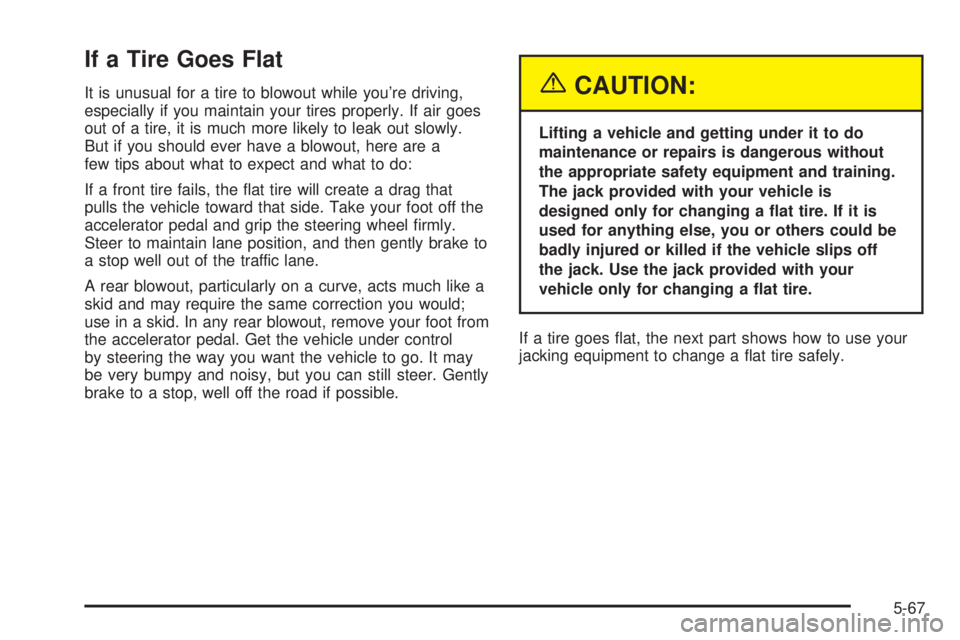
If a Tire Goes Flat
It is unusual for a tire to blowout while you’re driving,
especially if you maintain your tires properly. If air goes
out of a tire, it is much more likely to leak out slowly.
But if you should ever have a blowout, here are a
few tips about what to expect and what to do:
If a front tire fails, the �at tire will create a drag that
pulls the vehicle toward that side. Take your foot off the
accelerator pedal and grip the steering wheel �rmly.
Steer to maintain lane position, and then gently brake to
a stop well out of the traffic lane.
A rear blowout, particularly on a curve, acts much like a
skid and may require the same correction you would;
use in a skid. In any rear blowout, remove your foot from
the accelerator pedal. Get the vehicle under control
by steering the way you want the vehicle to go. It may
be very bumpy and noisy, but you can still steer. Gently
brake to a stop, well off the road if possible.{CAUTION:
Lifting a vehicle and getting under it to do
maintenance or repairs is dangerous without
the appropriate safety equipment and training.
The jack provided with your vehicle is
designed only for changing a �at tire. If it is
used for anything else, you or others could be
badly injured or killed if the vehicle slips off
the jack. Use the jack provided with your
vehicle only for changing a �at tire.
If a tire goes �at, the next part shows how to use your
jacking equipment to change a �at tire safely.
5-67
Page 365 of 410

Fuses Usage
DR/LCK
TRUNKDoor Locks, Trunk
RFA/MOD Remote Keyless Entry
PRK/SWTCH Ignition Key Lock
CLSTR Cluster
STR/WHL/
ILLUMSteering Wheel Controls Illumination
Fuses Usage
ONSTAR/ALDL OnStar®, Data Link
INT/ILLUM Interior Lamps
PWR/SEAT Power Seat
S/ROOF Sunroof
CNSTR Canister Vent
HVAC Climate Control System
HAZRD Turn Signal, Hazard
PRK/LAMP Park Lamps
CHMSL/BKUPCenter-High-Mounted
Stoplamp/Back-up Lamps
PWR/MIR Power Mirrors
CRUISE Cruise Control
RDO/AMP Radio, Ampli�er
HTD/SEAT Heated Seats
HTD/MIR Heated Mirrors
PWR/WNDW Power Window
Relays Usage
RAP Retained Accessory Power
PRK/LAMP Park Lamp Relay
R/DEFOG Rear Defogger Relay
5-89
Page 397 of 410
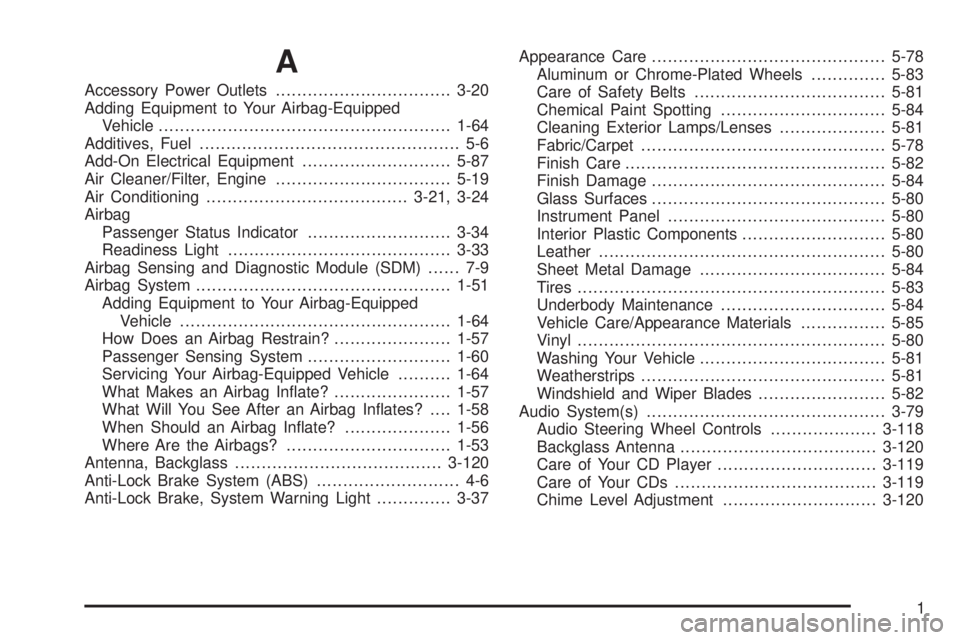
A
Accessory Power Outlets.................................3-20
Adding Equipment to Your Airbag-Equipped
Vehicle.......................................................1-64
Additives, Fuel................................................. 5-6
Add-On Electrical Equipment............................5-87
Air Cleaner/Filter, Engine.................................5-19
Air Conditioning......................................3-21, 3-24
Airbag
Passenger Status Indicator...........................3-34
Readiness Light..........................................3-33
Airbag Sensing and Diagnostic Module (SDM)...... 7-9
Airbag System................................................1-51
Adding Equipment to Your Airbag-Equipped
Vehicle...................................................1-64
How Does an Airbag Restrain?......................1-57
Passenger Sensing System...........................1-60
Servicing Your Airbag-Equipped Vehicle..........1-64
What Makes an Airbag In�ate?......................1-57
What Will You See After an Airbag In�ates?....1-58
When Should an Airbag In�ate?....................1-56
Where Are the Airbags?...............................1-53
Antenna, Backglass.......................................3-120
Anti-Lock Brake System (ABS)........................... 4-6
Anti-Lock Brake, System Warning Light..............3-37Appearance Care............................................5-78
Aluminum or Chrome-Plated Wheels..............5-83
Care of Safety Belts....................................5-81
Chemical Paint Spotting...............................5-84
Cleaning Exterior Lamps/Lenses....................5-81
Fabric/Carpet..............................................5-78
Finish Care.................................................5-82
Finish Damage............................................5-84
Glass Surfaces............................................5-80
Instrument Panel.........................................5-80
Interior Plastic Components...........................5-80
Leather......................................................5-80
Sheet Metal Damage...................................5-84
Tires..........................................................5-83
Underbody Maintenance...............................5-84
Vehicle Care/Appearance Materials................5-85
Vinyl..........................................................5-80
Washing Your Vehicle...................................5-81
Weatherstrips..............................................5-81
Windshield and Wiper Blades........................5-82
Audio System(s).............................................3-79
Audio Steering Wheel Controls....................3-118
Backglass Antenna.....................................3-120
Care of Your CD Player..............................3-119
Care of Your CDs......................................3-119
Chime Level Adjustment.............................3-120
1
Page 399 of 410
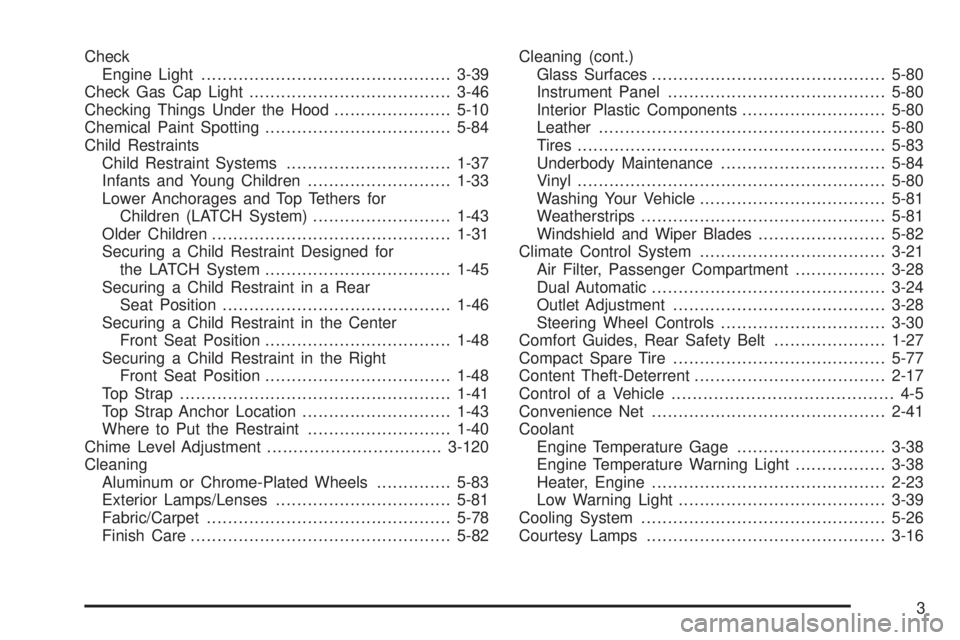
Check
Engine Light...............................................3-39
Check Gas Cap Light......................................3-46
Checking Things Under the Hood......................5-10
Chemical Paint Spotting...................................5-84
Child Restraints
Child Restraint Systems...............................1-37
Infants and Young Children...........................1-33
Lower Anchorages and Top Tethers for
Children (LATCH System)..........................1-43
Older Children.............................................1-31
Securing a Child Restraint Designed for
the LATCH System...................................1-45
Securing a Child Restraint in a Rear
Seat Position...........................................1-46
Securing a Child Restraint in the Center
Front Seat Position...................................1-48
Securing a Child Restraint in the Right
Front Seat Position...................................1-48
Top Strap...................................................1-41
Top Strap Anchor Location............................1-43
Where to Put the Restraint...........................1-40
Chime Level Adjustment.................................3-120
Cleaning
Aluminum or Chrome-Plated Wheels..............5-83
Exterior Lamps/Lenses.................................5-81
Fabric/Carpet..............................................5-78
Finish Care.................................................5-82Cleaning (cont.)
Glass Surfaces............................................5-80
Instrument Panel.........................................5-80
Interior Plastic Components...........................5-80
Leather......................................................5-80
Tires..........................................................5-83
Underbody Maintenance...............................5-84
Vinyl..........................................................5-80
Washing Your Vehicle...................................5-81
Weatherstrips..............................................5-81
Windshield and Wiper Blades........................5-82
Climate Control System...................................3-21
Air Filter, Passenger Compartment.................3-28
Dual Automatic............................................3-24
Outlet Adjustment........................................3-28
Steering Wheel Controls...............................3-30
Comfort Guides, Rear Safety Belt.....................1-27
Compact Spare Tire........................................5-77
Content Theft-Deterrent....................................2-17
Control of a Vehicle.......................................... 4-5
Convenience Net............................................2-41
Coolant
Engine Temperature Gage............................3-38
Engine Temperature Warning Light.................3-38
Heater, Engine............................................2-23
Low Warning Light.......................................3-39
Cooling System..............................................5-26
Courtesy Lamps.............................................3-16
3
Page 408 of 410

Spare Tire
Installing....................................................5-71
Removing...................................................5-69
Storing.......................................................5-76
Speci�cations, Capacities.................................5-92
Speedometer..................................................3-32
Split Folding Rear Seat..................................... 1-8
StabiliTrak
®System.......................................... 4-9
Starting Your Engine.......................................2-22
Steering........................................................4-10
Steering Wheel Comfort Controls......................3-30
Steering Wheel Controls, Audio.......................3-118
Steering Wheel, Tilt Wheel................................. 3-6
Storage Areas
Center Console Storage Area........................2-41
Convenience Net.........................................2-41
Cupholder(s)...............................................2-40
Glove Box..................................................2-40
Stuck in Sand, Mud, Ice or Snow......................4-28
Sun Visors.....................................................2-17
Sunroof.........................................................2-42
T
Tachometer....................................................3-32
Taillamps
Turn Signal, Sidemarker, Stoplamps, and
Back-Up Lamps.......................................5-48TCS Warning Light..........................................3-37
Theater Dimming............................................3-17
Theft-Deterrent, Radio....................................3-117
Theft-Deterrent Systems...................................2-17
Content Theft-Deterrent................................2-17
PASS-Key
®III .............................................2-19
PASS-Key®III Operation..............................2-19
Tilt Wheel........................................................ 3-6
Tires.............................................................5-52
Aluminum or Chrome-Plated Wheels,
Cleaning.................................................5-83
Buying New Tires........................................5-62
Chains.......................................................5-66
Changing a Flat Tire....................................5-68
Cleaning....................................................5-83
Compact Spare Tire.....................................5-77
If a Tire Goes Flat.......................................5-67
In�ation -- Tire Pressure...............................5-58
Inspection and Rotation................................5-60
Installing the Spare Tire................................5-71
Removing the Flat Tire.................................5-71
Removing the Spare Tire and Tools...............5-69
Storing a Flat or Spare Tire and Tools............5-76
Tire Sidewall Labelling..................................5-53
Tire Terminology and De�nitions....................5-55
Uniform Tire Quality Grading.........................5-63
Wheel Alignment and Tire Balance.................5-64
Wheel Replacement.....................................5-65
When It Is Time for New Tires......................5-61
12